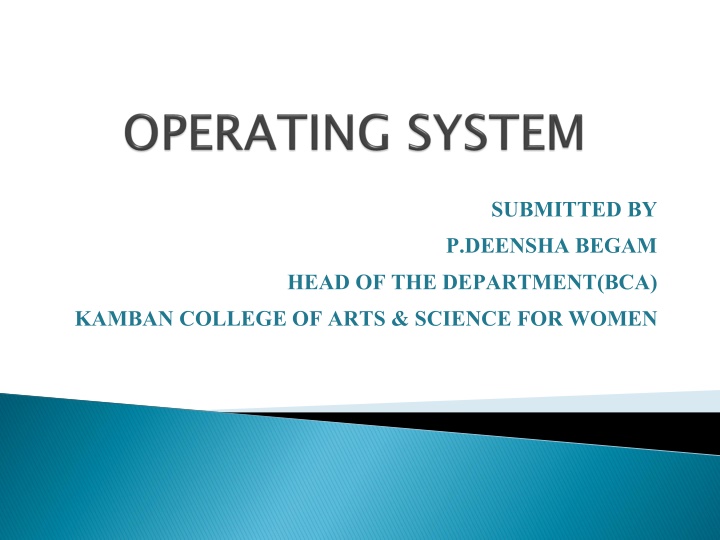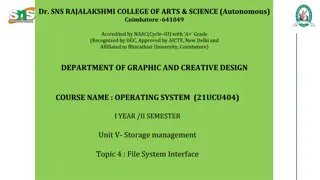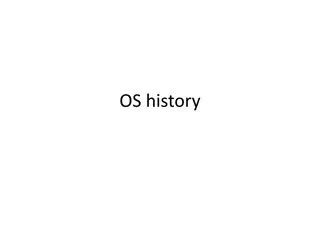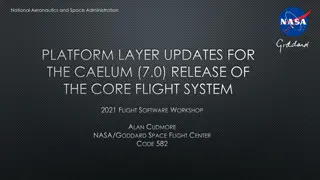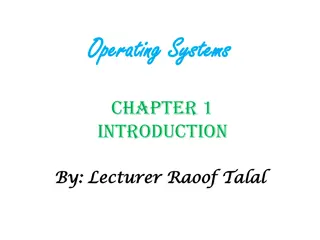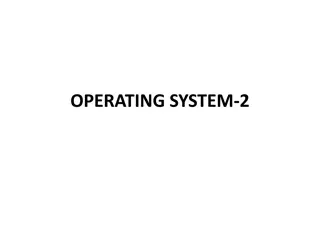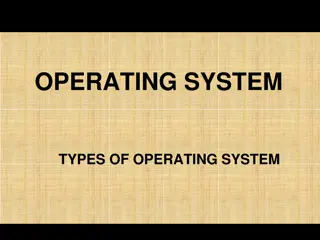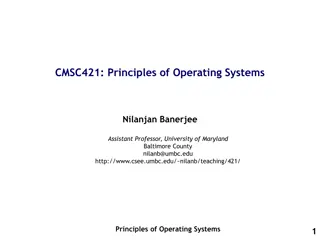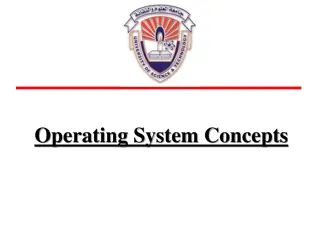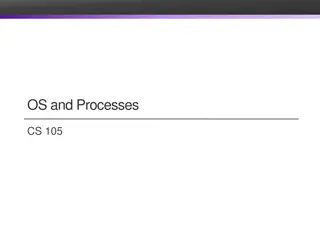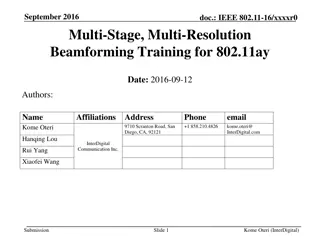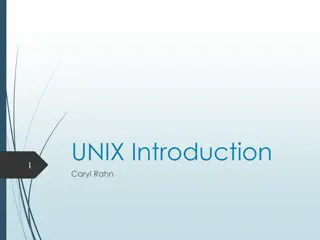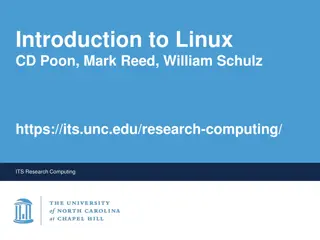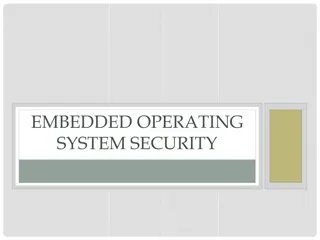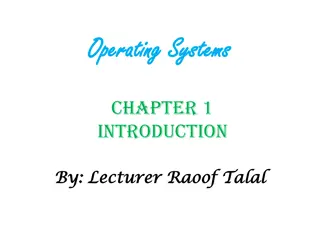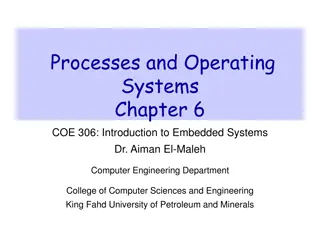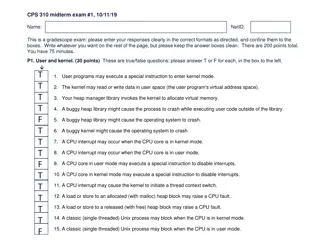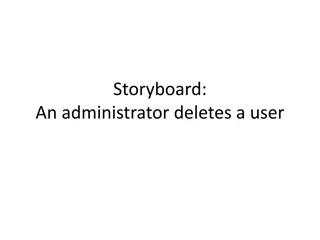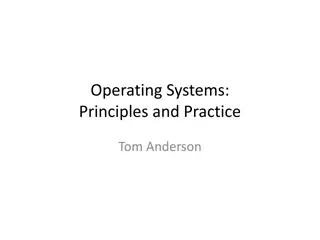Operating System Basics and Multi-User Systems
An operating system is a crucial program managing computer hardware, providing a platform for application programs, and facilitating user-computer interaction. This system enables efficient program execution and multitasking, with different system configurations based on the number of CPUs and device controllers. Multi-user systems allow multiple users to access programs simultaneously, while single-user and multiprocessor systems offer different functionalities. Operating systems play a vital role in optimizing CPU utilization through multitasking and job organization. Explore the diverse types and organization of computer systems to understand the importance and functionality of operating systems better.
Download Presentation

Please find below an Image/Link to download the presentation.
The content on the website is provided AS IS for your information and personal use only. It may not be sold, licensed, or shared on other websites without obtaining consent from the author.If you encounter any issues during the download, it is possible that the publisher has removed the file from their server.
You are allowed to download the files provided on this website for personal or commercial use, subject to the condition that they are used lawfully. All files are the property of their respective owners.
The content on the website is provided AS IS for your information and personal use only. It may not be sold, licensed, or shared on other websites without obtaining consent from the author.
E N D
Presentation Transcript
SUBMITTED BY P.DEENSHA BEGAM HEAD OF THE DEPARTMENT(BCA) KAMBAN COLLEGE OF ARTS & SCIENCE FOR WOMEN
OPERATING SYSTEM BASICS DEFINITION: An operating system is a program that manages a computer s hardware. It also provides a basis for application programs and acts as an intermediary between the computer hardware . The purpose of an operating system is to provide an environment in which a user can execute programs in a convenient and efficient manner. user and the computer
A modern general-purpose computer system consists of one or more CPUs and a number of device controllers connected through a common bus that provides access to shared memory
Multi-user: is the one that concede two or more users to use their programs at the same time. Some of O.S permits hundreds or even thousands of users simultaneously. Single-User: just allows one user to use the programs at one time. Multiprocessor: Supports opening the same program more than just in one CPU. Multitasking: Allows multiple programs running at the same time. Single-tasking: Allows different parts of a single program running at any one time.
A computer system can be organized in a number of different ways, which we can categorize roughly according to the number of Different types of Operating Systems for Different Kinds of Computer Environments are classified as Single processor system Multiprocessor system Clustered systems general-purpose processors used.
One of the most important aspects of operating systems is the ability to multi program. A single program cannot be kept either in the CPU or in the I/O devices as the processor will be busy at all times. Single users frequently have multiple Multiprogramming increases CPU utilization by organizing jobs (code and data) so that the CPU always has one to execute. programs running.
The operating system keeps several jobs in memory simultaneously. Since main memory is too small to accommodate all jobs, the jobs are kept initially on the disk in the job pool. This pool consists of all processes residing on disk awaiting allocation of main memory. The set of jobs in memory can be a subset of the jobs kept in the job pool. The operating system picks and begins to execute one of the jobs in memory.
Time of multiprogramming. In time-sharing systems, the CPU executes multiple jobs by switching among them, but the switches occur so frequently that the users can interact with each program while it is running Time sharing sharing (or multitasking multitasking) is a logical extension
A program does nothing unless its instructions are executed by a CPU. A program in execution, as mentioned, is a process. A time-shared user program such as a compiler is a process. A process needs certain resources including CPU time, memory, files, and I/O devices to accomplish its task. These resources are either given to the process when it is created or allocated to it while it is running. A program by itself is not a process. A program is a passive entity, like the contents of a file stored on disk, whereas a process is an active entity.
CPU SCHEDULING: Whenever the CPU becomes idle, the operating system must select one of the processes in the ready queue to be executed. The selection process is carried out by the short- term scheduler (or CPU scheduler). The scheduler selects from among the processes in memory that are ready to execute, and allocates the CPU to one of them. Selection of process by CPU follows the scheduling algorithm. CPU scheduling decisions may take place when a process: Switches from running to waiting state Switches from running to ready state Switches from waiting to ready Terminates
First Come First Serve (FCFS) scheduling algorithm simply schedules the jobs according to their arrival time. The job which comes first in the ready queue will get the CPU first. The lesser the arrival time of the job, the sooner will the job get the CPU. FCFS scheduling may cause the problem of starvation if the burst time of the first process is the longest among all the jobs. First Come First Serve is just like FIFO (First in First out) Queue data structure, where the data element which is added to the queue first, is the one who leaves the queue first.
SJF scheduling algorithm, schedules the processes according to their burst time. In SJF scheduling, the process with the lowest burst time, among the list of available processes in the ready queue, is going to be scheduled next. However, it is very difficult to predict the burst time needed for a process hence this algorithm is very difficult to implement in the system.
The round-robin (RR) scheduling technique is intended mainly for time-sharing systems. This algorithm is related to FCFS scheduling, but pre-emption is included to toggle among processes. A small unit of time which is termed as a time quantum or time slice has to be defined. A 'time quantum' is usually from 10 to 100 milliseconds. The ready queue gets treated with a circular queue. The CPU scheduler goes about the ready queue, allocating the CPU with each process for the time interval which is at least 1-time quantum.
Scheduler consider the priority of processes. The priority assigned to each process and CPU allocated to highest priority process. Equal priority processes scheduled in FCFS order. Priority can be discussed regarding Lower and higher priority. Numbers denote it. We can use 0 for lower priority as well as more top priority. There is not a hard and fast rule to assign numbers to preferences.
This Scheduling algorithm has been created for situations in which processes are easily classified into different groups. System Processes Interactive Processes Interactive Editing Processes Batch Processes Student Processes
A deadlock happens in operating system when two or more processes need some resource to complete their execution that is held by the other process.
A Deadlock is a situation where each of the computer process waits for a resource which is being assigned to some another process. In this situation, none of the process gets executed since the resource it needs, is held by some other process which is also waiting for some other resource to be released. Let us assume that there are three processes P1, P2 and P3. There are three different resources R1, R2 and R3. R1 is assigned to P1, R2 is assigned to P2 and R3 is assigned to P3.
Deadlock prevention or avoidance - Do not allow the system to get into a deadlocked state. Deadlock detection and recovery - Abort a process or preempt some resources when deadlocks are detected. Ignore the problem all together - If deadlocks only occur once a year or so, it may be better to simply let them happen and reboot as necessary than to incur the constant overhead and system performance penalties associated with deadlock prevention or detection.
Safe, unsafe, and deadlocked state spaces. Safe, unsafe, and deadlocked state spaces.
MEMORY MANAGEMENT Memory accesses and memory management are a very important part of modern computer operation. Every instruction has to be fetched from memory before it can be executed, and most instructions involve retrieving data from memory or storing data in memory or both. The base register holds the smallest legal physical memory address; the limit register specifies the size of the range. For example, if the base register holds 300040 and the limit register is 120900, then the program can legally access all addresses from 300040 through 420939.
Compile Time - If it is known at compile time where a program will reside in physical memory, then absolute code can be generated by the compiler, containing actual physical addresses. However if the load address changes at some later time, then the program will have to be recompiled. DOS .COM programs use compile time binding. Load Time - If the location at which a program will be loaded is not known at compile time, then the compiler must generate relocatable code, which references addresses relative to the start of the program. If that starting address changes, then the program must be reloaded but not recompiled. Execution Time - If a program can be moved around in memory during the course of its execution, then binding must be delayed until execution time. This requires special hardware, and is the method implemented by most modern OS.
An address generated by the CPU is commonly referred to as a logical address, whereas an address seen by the memory unit that is, the one loaded into the memory- address register of the memory is commonly referred to as a physical address. The compile-time and load-time address-binding methods generate identical logical and physical addresses. However, the execution-time address binding scheme results in differing logical and physical addresses. In this case, we usually refer to the logical address as a virtual address. The set of all logical addresses generated by a program is a logical address space; the set of all physical addresses corresponding to these logical addresses is a physical address space. Thus, in the execution- time address-binding scheme, the logical and physical address spaces differ.
First fit - Search the list of holes until one is found that is big enough to satisfy the request, and assign a portion of that hole to that process. Whatever fraction of the hole not needed by the request is left on the free list as a smaller hole. Subsequent requests may start looking either from the beginning of the list or from the point at which this search ended. Best fit - Allocate the smallest hole that is big enough to satisfy the request. This saves large holes for other process requests that may need them later, but the resulting unused portions of holes may be too small to be of any use, and will therefore be wasted. Keeping the free list sorted can speed up the process of finding the right hole. Worst fit - Allocate the largest hole available, thereby increasing the likelihood that the remaining portion will be usable for satisfying future requests.
Fragmentation occurs in a dynamic memory allocation system when many of the free blocks are too small to satisfy any request . Fragmentation refers to the condition of a disk in which files are divided into pieces scattered around the disk. Fragmentation occurs naturally when you use a disk frequently, creating, deleting, and modifying files. At some point, the operating system needs to store parts of a file in non-contiguous clusters.
BASIS FOR COMPARISON INTERNAL FRAGMENTATION EXTERNAL FRAGMENTATION Basic It occurs when fixed sized It occurs when variable size memory blocks are allocated to the processes. memory space are allocated to the processes dynamically. Occurrence When the memory assigned to When the process is removed the process is slightly larger than from the memory, it creates the the memory requested by the free space in the memory causing process this creates free space in external the allocated block causing fragmentation. fragmentation. internal Solution The memory must be partitioned Compaction, paging into variable sized blocks and and segmentation. assign the best fit block to the process.
The use of compaction is to minimize the probability of external fragmentation. In compaction, all the free partitions are made contiguous and all the loaded partitions are brought together. By applying this technique, we can store the bigger processes in the memory. The free partitions are merged which can now be allocated according to the needs of new processes. This technique is also called defragmentation.
SWAPPING Swapping of two processes using a disk as a backing store
Another way of keeping track of memory is to maintain a linked list of allocated and free memory segments, where a segment is either a process or a hole between two processes. In linked list each entry in the list specifies a hole (H) or process (P), the address at which it starts, the length, and a pointer to the next entry. This gives an example, in which the segment list is kept sorted by address. Sorting this way has the advantage that when a process terminates or is swapped out, updating the list is straightforward.
Definition: Paging is a memory-management scheme that permits the physical address space of a process to be non-contiguous. Paging fragmentation and the need for compaction. It also solves the considerable problem of fitting memory chunks of varying sizes onto the backing store. The problem arises because, when some code fragments or data residing in main memory need to be swapped out, space must be found on the backing store. avoids external
An executable program must be loaded from disk into memory. One option is to load the entire program in physical memory at program execution time. Loading the entire program into memory results in loading the executable code for all options, regardless of whether an option is ultimately selected by the user or not. An alternative strategy is to load pages only as they are needed. This technique is known as demand paging and is commonly used in virtual memory systems. With demand-paged virtual memory, pages are loaded only when they are demanded during program execution. Pages that are never accessed are never loaded into the physical memory.
In an operating system that uses paging for memory management, a page replacement algorithm is needed to decide which page needs to be replaced when new page comes in. Page Fault A page fault happens when a running program accesses a memory page that is mapped into the virtual address space, but not loaded in physical memory. Since actual physical memory is much smaller than virtual memory, page faults happen. In case of page fault, Operating System might have to replace one of the existing pages with the newly needed page. Different page replacement algorithms suggest different ways to decide which page to replace. The target for all algorithms is to reduce the number of page faults.
FILE MANAGEMENT: A file has a certain defined structure according to its type. A text file is a sequence of characters organized into lines (and possibly pages). A Source file is a sequence of sub routines and functions, each of which is further organized as declarations followed by executable statements. An Object file sequence of bytes organized into blocks understandable by the systems linker. An executable file is series of code sections that the loader can bring into memory and execute.
Creating a file: To create a file two steps are necessary,Space in the file system must be found for the file. Writing a file: To write a file,Make a system call specifying both the name of the file and the information to be written to the file. Reading a file:To read from a file, Use a system call that specifies the name of the file and where (in memory) the next block of the file should be put.
Repositioning within a file The directory is searched for the appropriate entry, and the current file- position is set to a given value. Repositioning within a file does not need to involve any actual I/O. This file operation is also known as a file seek. Deleting a file: To delete a file, We Search the directory for the named file, when found the associated directory entry, then release all file space, so that it can be reused by other files, and erase the directory entry. Truncating a file The user may want to erase the contents of a file but keep its attributes. Rather than forcing the user to delete the file and the recreate it, this function allows all attributes to remain unchanged except for the file length, but lets the file set to length zero and its file space released.
